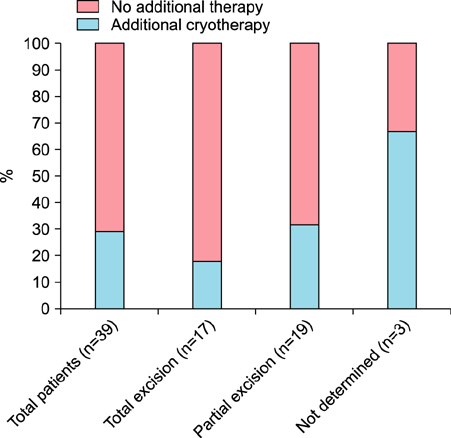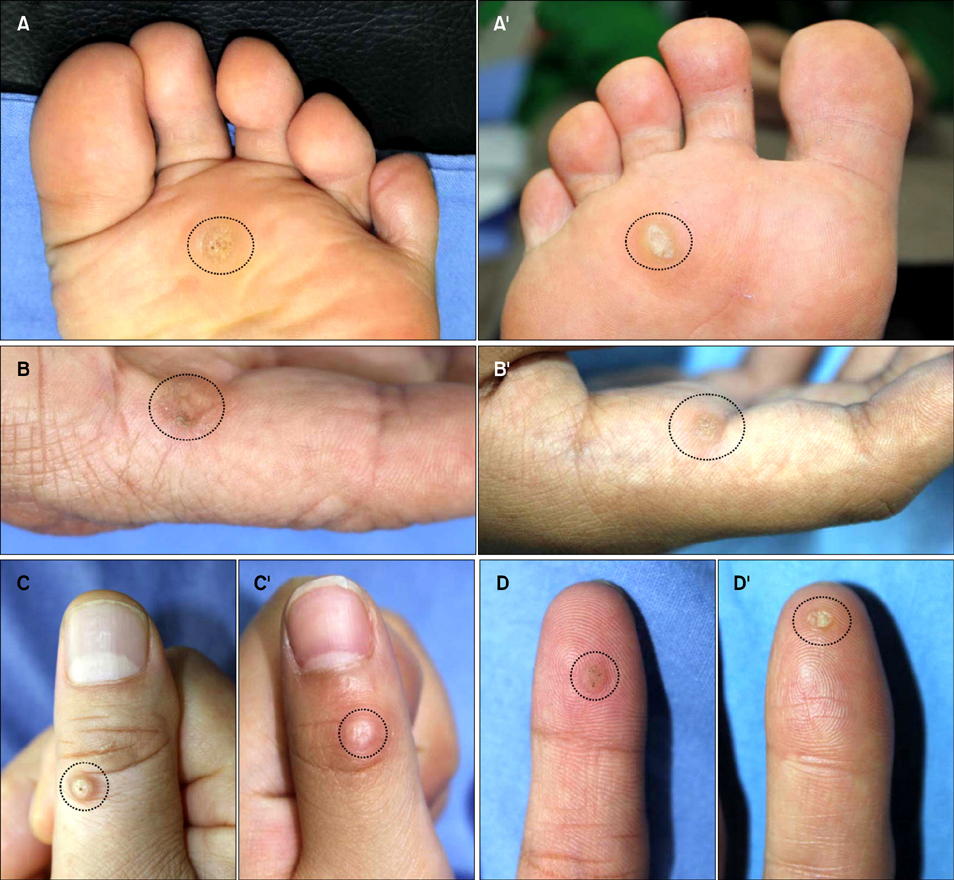Ann Dermatol.
2017 Apr;29(2):200-205. 10.5021/ad.2017.29.2.200.
Efficacy of Punch Reduction Prior to Cryotherapy in Patients with Viral Warts: A Case-Control Study in a Single Tertiary Center
- Affiliations
-
- 1Department of Dermatology, Kangbuk Samsung Hospital, Sungkyunkwan University School of Medicine, Seoul, Korea.
- 2Department of Dermatology, Samsung Medical Center, Sungkyunkwan University School of Medicine, Seoul, Korea. jh1204@samsung.com
- KMID: 2394844
- DOI: http://doi.org/10.5021/ad.2017.29.2.200
Abstract
- BACKGROUND
Cutaneous warts are a common complaint to visit dermatologic clinic and its course is variable, ranging from spontaneous resolution to a chronic condition refractory to treatment.
OBJECTIVE
To evaluate the efficacy and safety of punch biopsy for cutaneous warts.
METHODS
Thirty-nine patients who received punch biopsy for warts were reviewed through charts and photos. Among them, 15 were matched with cryotherapy-only controls in terms of size and location of the wart. We compared the number and cost of treatments between the two groups.
RESULTS
Eleven of the total 39 patients were treated with cryotherapy in addition to punch biopsy and the average number of treatments was 4.1±3.3 (mean±standard deviation). In a case-control study, the ratio value of cost was 2.9±3.6 in the experimental group and was 5.9±4.1 in controls (p<0.05).
CONCLUSION
Punch biopsies can decrease the number and cost of treatment by reducing the size of warts and inducing local inflammation to accelerate resolution. Therefore, punch reduction should be considered as a viable measure to treat warts.
Keyword
Figure
Reference
-
1. Goldsmith LA, Katz SI, Gilchrest BA, Paller AS, Leffell DJ, Wolff K. Fitzpatrick's dermatology in general medicine. 8th ed. New York: McGraw-Hill Medical;2012. p. 2421–2433.2. Benton EC. Therapy of cutaneous warts. Clin Dermatol. 1997; 15:449–455.
Article3. Kilkenny M, Merlin K, Young R, Marks R. The prevalence of common skin conditions in Australian school students: 1. Common, plane and plantar viral warts. Br J Dermatol. 1998; 138:840–845.
Article4. Kyriakis K, Pagana G, Michailides C, Emmanuelides S, Palamaras I, Terzoudi S. Lifetime prevalence fluctuations of common and plane viral warts. J Eur Acad Dermatol Venereol. 2007; 21:260–262.5. van Haalen FM, Bruggink SC, Gussekloo J, Assendelft WJ, Eekhof JA. Warts in primary schoolchildren: prevalence and relation with environmental factors. Br J Dermatol. 2009; 161:148–152.
Article6. Massing AM, Epstein WL. Natural history of warts. A two-year study. Arch Dermatol. 1963; 87:306–310.7. Sterling JC, Handfield-Jones S, Hudson PM. British Association of Dermatologists. Guidelines for the management of cutaneous warts. Br J Dermatol. 2001; 144:4–11.
Article8. Gibbs S, Harvey I, Sterling J, Stark R. Local treatments for cutaneous warts: systematic review. BMJ. 2002; 325:461.9. Bacelieri R, Johnson SM. Cutaneous warts: an evidence-based approach to therapy. Am Fam Physician. 2005; 72:647–652.10. Bruggink SC, Gussekloo J, de Koning MN, Feltkamp MC, Bavinck JN, Quint WG, et al. HPV type in plantar warts influences natural course and treatment response: secondary analysis of a randomised controlled trial. J Clin Virol. 2013; 57:227–232.
Article11. Micali G, Dall'Oglio F, Nasca MR, Tedeschi A. Management of cutaneous warts: an evidence-based approach. Am J Clin Dermatol. 2004; 5:311–317.12. Dall'oglio F, D'Amico V, Nasca MR, Micali G. Treatment of cutaneous warts: an evidence-based review. Am J Clin Dermatol. 2012; 13:73–96.13. Kwok CS, Gibbs S, Bennett C, Holland R, Abbott R. Topical treatments for cutaneous warts. Cochrane Database Syst Rev. 2012; (9):CD001781.
Article14. Sterling JC, Gibbs S, Haque Hussain SS, Mohd Mustapa MF, Handfield-Jones SE. British Association of Dermatologists' guidelines for the management of cutaneous warts 2014. Br J Dermatol. 2014; 171:696–712.
Article15. Jin SP, Jeon YK, Cho KH, Chung JH. A rapidly regressing wart following biopsy. Ann Dermatol. 2011; 23:123–124.
Article16. Coleman N, Birley HD, Renton AM, Hanna NF, Ryait BK, Byrne M, et al. Immunological events in regressing genital warts. Am J Clin Pathol. 1994; 102:768–774.
Article
- Full Text Links
- Actions
-
Cited
- CITED
-
- Close
- Share
- Similar articles
-
- A Retrospective Analysis of Efficacy and Recurrence Rate for Viral Warts Treated by Cryotherapy
- Does Immunotherapy of Viral Warts Provide Beneficial Effects When It Is Combined with Conventional Therapy?
- A Two-week Interval Is Better Than a Three-week Interval for Reducing the Recurrence Rate of Hand-foot Viral Warts after Cryotherapy: A Retrospective Review of 560 Hand-foot Viral Warts Patients
- A Clinical Study on Viral Warts in Five-Year-Period (2007~2011)
- Cryotherpy of warts with liquid nitrogen




